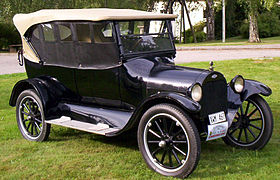| Chevrolet Series 490 | |
|---|---|
 1922 Chevrolet 490 touring car | |
| Overview | |
| Manufacturer | Chevrolet Motor Company (pre-GM) |
| Also called | Chevrolet Four-Ninety |
| Production | 1915–1922 |
| Assembly | Oakland Assembly, Oakland, California North Tarrytown Assembly, Tarrytown, New York Flint Assembly, Flint, Michigan Norwood Assembly, Norwood, Ohio St. Louis Assembly, St. Louis, Missouri Oshawa Assembly, Oshawa, Ontario, Canada |
| Body and chassis | |
| Class | mid-size |
| Body style | 4-door touring 2-door roadster 2-door coupe (added 1918) 3-door sedan (added 1918) chassis "cowl" truck (added 1918) |
| Layout | FR layout |
| Related | Chevrolet Series D |
| Powertrain | |
| Engine | 171 in3, 24 hp (18 kW) Chevrolet Straight-4 engine |
| Transmission | Selective-sliding 3-speed cone clutch[1][2] |
| Dimensions | |
| Wheelbase | 102 in (2,591 mm)[1] |
| Chronology | |
| Predecessor | Chevrolet Series H |
| Successor | Chevrolet Superior |
The Chevrolet Series 490 (or Four-Ninety) is an early American automobile, made from 1915 to 1922 by Chevrolet. Introduced in June 1915, the Chevrolet 490 was sold for $490 ($14,758 in 2023 dollars [3]).[4] It was an immediate success and established the brand as a big player. The name would not denote the price for long (in 1921, the average price was $820[5]), but it would stay low enough to take a chunk out of the Model T market. The Model T started at $495 at the time. Chevrolet was soon so profitable that Chevrolet owner Billy Durant began buying shares of GM stock with his Chevrolet stock, enough that he was able to take control of GM and merge Chevrolet with it. Electric horns were standard.[4] And by 1921, standard equipment included a speedometer, and ammeter, dome lights (closed-body cars only), and headlight dimmers.[6]
- ^ a b Kimes, Beverly (1996). standard catalog of American Cars 1805-1942. Krause publications. ISBN 0-87341-428-4.
- ^ "Directory Index: Chevrolet/1916_Chevrolet/1916_Chevrolet_490_Brochure". Oldcarbrochures.com. Retrieved September 8, 2012.
- ^ 1634–1699: McCusker, J. J. (1997). How Much Is That in Real Money? A Historical Price Index for Use as a Deflator of Money Values in the Economy of the United States: Addenda et Corrigenda (PDF). American Antiquarian Society. 1700–1799: McCusker, J. J. (1992). How Much Is That in Real Money? A Historical Price Index for Use as a Deflator of Money Values in the Economy of the United States (PDF). American Antiquarian Society. 1800–present: Federal Reserve Bank of Minneapolis. "Consumer Price Index (estimate) 1800–". Retrieved February 29, 2024.
- ^ a b "Directory Index: Chevrolet/1916_Chevrolet/1916_Chevrolet_490_Brochure". Oldcarbrochures.com. Retrieved September 8, 2012.
- ^ "Directory Index: Chevrolet/1921_Chevrolet/1921_Chevrolet_Data_Sheets". Oldcarbrochures.com. Retrieved September 8, 2012.
- ^ "Directory Index: Chevrolet/1921_Chevrolet/1921_Chevrolet_Data_Sheets". Oldcarbrochures.com. Retrieved September 8, 2012.